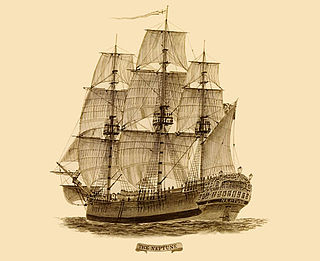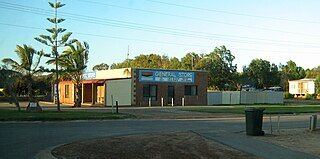Related Research Articles

The First Fleet was a fleet of 11 British ships that brought the first British colonists and convicts to Australia. It was made up of two Royal Navy vessels, three store ships and six convict transports. On 13 May 1787 the fleet under the command of Captain Arthur Phillip, with over 1400 people, left from Portsmouth, England and took a journey of over 24,000 kilometres (15,000 mi) and over 250 days to eventually arrive in Botany Bay, New South Wales, where a penal colony would become the first British settlement in Australia.
Alexander was a merchant ship launched at Hull in 1783 or 1784. She was one of the vessels in the First Fleet, that the British government hired to transport convicts for the European colonisation of Australia in 1788. On her return voyage from Australia the British East India Company permitted her to carry a cargo from Canton back to Britain. Thereafter she traded out of London until 1809, when she is no longer listed.
The Second Fleet was a convoy of six ships carrying settlers, convicts and supplies to Sydney Cove, Australia in 1790. It followed the First Fleet which established European settlement in Australia in the previous year.

Surprize was a three-deck merchant vessel launched in 1780 that made five voyages as a packet ship under charter to the British East India Company (EIC). The fourth of which was subsequent to her participating in the notorious Second Fleet transporting convicts to Port Jackson (EIC). Her fifth voyage for the EIC was subsequent to her second voyage transporting convicts to Australia. In 1799 a French frigate captured her in the Bay of Bengal.
The Third Fleet comprised 11 ships that set sail from the Kingdom of Great Britain in February, March and April 1791, bound for the Sydney penal settlement, with more than 2,000 convicts aboard. The passengers comprised convicts, military personnel and notable people sent to fill high positions in the colony. More important for the fledgling colony was that the ships also carried provisions.

HMD Bermuda was the principal base of the Royal Navy in the Western Atlantic between American independence and the Cold War. The Imperial fortress colony of Bermuda had occupied a useful position astride the homeward leg taken by many European vessels from the New World since before its settlement by England in 1609. French privateers may have used the islands as a staging place for operations against Spanish galleons in the 16th century. Bermudian privateers certainly played a role in many English and British wars following settlement, with its utility as a base for his privateers leading to the Earl of Warwick, the namesake of Warwick Parish, becoming the most important investor of the Somers Isles Company. Despite this, it was not until the loss of bases on most of the North American Atlantic seaboard threatened Britain's supremacy in the Western Atlantic that the island assumed great importance as a naval base. In 1818 the Royal Naval Dockyard, Bermuda officially replaced the Royal Naval Dockyard, Halifax, as the British headquarters for the North America Station (which would become the North America and West Indies Station after absorbing the Jamaica Station in 1830.

A convict ship was any ship engaged on a voyage to carry convicted felons under sentence of penal transportation from their place of conviction to their place of exile.
Foveaux Strait is the centre of attention for sealing ships. Sealing gangs are dropped along the coast from southern Fiordland to Otago Harbour and on Stewart Island/Rakiura. The Bay of Islands is sometimes on the journey to or from Port Jackson. The Chatham Islands are also visited. A few whalers also operate around New Zealand; some also collect timber from Bay of Islands.
Three Bees was launched at Bridgwater in 1813. Her first voyage was transporting convicts to New South Wales. After she arrived at Sydney Cove in 1814 she caught fire and was destroyed.

Gregory is a small town and fishing port located 7 km (4.3 mi) northwest of the mouth of the Hutt River, in the Mid West region of Western Australia. At the 2016 census, Gregory had a population of 64 in 83 dwellings. Most of the dwellings are holiday houses. The population of Gregory fluctuates depending on tourism; with the town at full capacity during school holidays and throughout the summer. During the census 50% of dwellings were unoccupied.
Captain John Black, was an English seafarer, who had a short but eventful career that included privateering and exploration. He was best known, during his own lifetime, for a mutiny on Lady Shore in August 1797, as it sailed south in the Atlantic Ocean, bound for Sydney, New South Wales, carrying female convicts. As a result of the mutiny, Black and several other members of the crew were put into a small boat and left to find their way to the nearest land, being Brazil.
The first humans are thought to have arrived in New Zealand from Polynesia some time around 1300 AD. The people, who later became known as Māori, eventually travelled to almost every part of the country. Their arrival had a significant impact on the local fauna, particularly the flightless birds such as moa.

HMS Calcutta was the East Indiaman Warley, converted to a Royal Navy 56-gun fourth rate. This ship of the line served for a time as an armed transport. She also transported convicts to Australia in a voyage that became a circumnavigation of the world. The French 74-gun Magnanime captured Calcutta in 1805. In 1809, after she ran aground during the Battle of the Basque Roads and her crew had abandoned her, a British boarding party burned her.
Archduke Charles was built in Newcastle, England in 1809. She was sheathed in copper in 1810 and partially resheathed with copper in 1812. She made one voyage transporting convicts from Ireland to New South Wales, and on her return voyage to Britain she carried a cargo from China for the British East India Company (EIC). She was wrecked in 1816 while carrying troops from Quebec to Nova Scotia.
Indefatigable was a square-rigged, three-decked, three-masted merchant ship launched in 1799 at Whitby for James Atty & Co. for the West Indies trade. In 1804 she served as an armed defense ship and recaptured a merchantman that a privateer had captured. She was a transport in the 1805–1806 British invasion of the Dutch Cape colony. She twice transported convicts to Australia; on the first trip she was chartered to the British East India Company (EIC). She burned to the waterline in 1815.

The Cyprus mutiny took place on 14 August 1829 in Recherche Bay off the British penal settlement of Van Diemen's Land. Convicts seized the brig Cyprus and sailed her to Canton, China, where they scuttled her and claimed to be castaways from another vessel. On the way, Cyprus visited Japan during the height of the period of severe Japanese restrictions on the entry of foreigners, the first ship from Australia to do so.
Countess of Harcourt was a two-decker, teak merchant ship launched at Prince of Wales's Island in 1811, and sold in Great Britain in 1814. An American privateer captured her in 1814, but the British recaptured her in 1815. Later, she made five trips transporting convicts to Australia. Between the third and fourth of these, she undertook a voyage to China and Nova Scotia while under charter to the British East India Company (EIC). She was wrecked in late 1830.
Norfolk Island twice served as a penal colony, from March 1788 to February 1814, and from 1825 to 1853. During both periods the government in the Colony of New South Wales transferred convicts that had been brought to Australia on to the island.
The Hive Shipwreck is a heritage-listed shipwreck site of the Hive, a former convict transportation ship located approximately 40 metres (130 ft) off Bherwerre Beach, Jervis Bay Territory, Australia. It was added to the New South Wales State Heritage Register on 1 April 2010.

The Badger escape occurred in July 1833 when twelve convicts in the British penal colony of Van Diemen's Land used the government schooner Badger to escape to Macau, China. Most of the convicts involved were experienced seafarers who had been appointed to man the vessel soon after their transportation. For this, the colonial press accused the government of extreme negligence, and also called for the removal of lieutenant-governor George Arthur. In The History of Tasmania (1852), John West wrote that, of all the escapes from Van Diemen's Land, "never was the government more culpable, or the prisoners less so, than in the instance of the Badger".
References
- Bateson, Charles (1959). The Convict Ships. Brown, Son & Ferguson. OCLC 3778075.